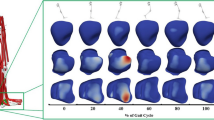Abstract
Ankle-foot orthoses are frequently used interventions to correct pathological gait. Their effects on the kinematics and kinetics of the proximal joints are of great interest when prescribing ankle-foot orthoses to specific patient groups. Mathematical Dynamic Model (MADYMO) is developed to simulate motor vehicle crash situations and analyze tissue injuries of the occupants based multibody dynamic theories. Joint kinetics output from an inverse model were perturbed and input to the forward model to examine the effects of changes in the internal sagittal ankle moment on knee and hip kinematics following heel strike. Increasing the internal ankle moment (augmentation, equivalent to gastroc-soleus contraction) produced less pronounced changes in kinematic results at the hip, knee and ankle than decreasing the moment (attenuation, equivalent to gastroc-soleus relaxation). Altering the internal ankle moment produced two distinctly different kinematic curve morphologies at the hip. Decreased internal ankle moments increased hip flexion, peaking at roughly 8% of the gait cycle. Increasing internal ankle moments decreased hip flexion to a lesser degree, and approached normal at the same point in the gait cycle. Increasing the internal ankle moment produced relatively small, well-behaved extension-biased kinematic results at the knee. Decreasing the internal ankle moment produced more substantial changes in knee kinematics towards flexion that increased with perturbation magnitude. Curve morphologies were similar to those at the hip. Immediately following heel strike, kinematic results at the ankle showed movement in the direction of the internal moment perturbation. Increased internal moments resulted in kinematic patterns that rapidly approach normal after initial differences. When the internal ankle moment was decreased, differences from normal were much greater and did not rapidly decrease. This study shows that MADYMO can be successfully applied to accomplish forward dynamic simulations, given kinetic inputs. Future applications include predicting muscle forces and decomposing external kinetics.







Similar content being viewed by others
References
Anderson FC, Pandy MG (2001) Dynamic optimization of human walking. J Biomech Eng 123:381–390
Anderson FC, Pandy MG (2003) Individual muscle contributions to support in normal walking. Gait Posture 17:159–169
Gonik B, Zhang N, Grimm MJ (2003) Prediction of brachial plexus stretching during shoulder dystocia using a computer simulation model. Am J Obstet Gynecol 189:1168–72
Harris GF, Smith PA (1996) Human motion analysis. IEEE, New York
Harris SR, Riffle K (1986) Effects of inhibitive ankle-foot orthoses on standing balance in a child with cerebral palsy. Phys Ther 66:663–667
Johnson JE, Lamdan R, Granberry WF, Harris GF, Carrera GF (1999) Hindfoot coronal alignment: a modified radiographic method. Foot Ankle Int 20:818–825
Kennett K, Lai W, Kelkar R (2001) Modeling of falls and jumps. In: The fourth MADYMO User’s meeting of the America’s, Detroit, MI
Kidder SM, Abuzzahab FS, Harris GF, Johnson JE (1996) A system for the analysis of foot and ankle kinematics during gait. IEEE Trans Rehab Eng 4:25–32
Lloyd DG, Besier TF (2003) An EMG-driven musculoskeletal model to estimate muscle forces and knee joint moments in vivo. J Biomech 36:765–776
MADYMO (2004a) MADYMO human models manual, ver 6.2. TNO Automotive, Delft, Netherlands
MADYMO (2004b) MADYMO theory manual, ver 6.2. TNO Automotive, Delft, Netherlands
Manning P, Owen C, Roberts A, Oakley C, Lowne R, Wallace A (1998) Dynamic response and injury mechanism in the human foot and ankle and an analysis of dummy biofidelity. ESV 98-S9-O-11
Moran SG, Key JS, McGwin G, Keeley JW, Davidson JS, Rue LW (2004) The applicability of a computer model for predicting head injury incurred during actual motor vehicle collisions. J Trauma Inj Infect Crit Care 57:99–103
Myers KA, Wang M, Marks RM, Harris GF (2004) Validation of a multisegment foot and ankle kinematic model for pediatric gait. IEEE Trans Rehab Eng 12:122–130
Neptune RR, Kautz SA, Zajac FE (2001) Contributions of the individual ankle plantar flexors to support, forward progression and swing initiation during normal walking. J Biomech 34:387–398
Perry J (1992) Gait analysis: normal and pathological function. Slack, Thorofare
Rosenthal RK (1984) The use of orthotics in foot and ankle problems in cerebral palsy. Foot Ankle 4:195–200
Smith PA, Harris GF (2000) Pediatric gait. IEEE, New York
Thelen DG, Anderson FC, Delp SL (2003) Generating dynamic simulations of movement using computed muscle control. J Biomech 36:321–328
Winter DA (1991) The biomechanics and motor control of human gait: normal, elderly, and pathological. University of Waterloo Press, Waterloo
Zajac FE, Neptune RR, Kautz SA (2002) Biomechanics and muscle coordination of human walking Part I: Introduction to concepts, power transfer, dynamics and simulations. Gait Posture 16:215–232
Acknowledgment
This project was supported by the Orthopaedic Rehabilitation and Engineering Center (OREC) and Shriners Hospital for Children, Chicago.
Author information
Authors and Affiliations
Corresponding author
Rights and permissions
About this article
Cite this article
Meyer, A.R., Wang, M., Smith, P.A. et al. Modeling initial contact dynamics during ambulation with dynamic simulation. Med Bio Eng Comput 45, 387–394 (2007). https://doi.org/10.1007/s11517-007-0166-1
Received:
Accepted:
Published:
Issue Date:
DOI: https://doi.org/10.1007/s11517-007-0166-1




